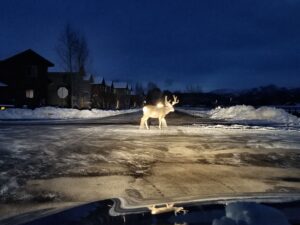By Renee Seidler
Sunday November 5th at 2 am is the end of Daylight Saving Time!
Why do we care?
The end of Daylight Saving Time, an age-old practice that is supposed to give us more waking daylight hours, is the number one worst day for wildlife-vehicle collisions in the US. That may seem odd, so let me explain. Animals (and plants!) are amazing creatures with the ability to adapt to changing environmental conditions (albeit there is almost always a time gap to achieve the greatest adjustment due to the ‘learning curve’). Animals move across the landscape to seek food and water and they move away from threats and hazards. They do this adaptively; for example, mule deer migrate in the spring following a ‘green wave’ of maturing plants as snows melt and temperatures warm, only to repeat the migration in reverse in the fall to find the most accessible winter forage such as on wind-swept or south-facing ridges.

How can you avoid getting into a collision with an animal? Knowing this information is a good start!
These animals adjust their departure time and movements each year to find the best forage. Believe it or not, these animals know our commuting hours! When we are driving through that annoying rush-hour to get home, animals avoid crossing the road as best as they can, even when the resources they need are on the other side of the road. In fact, they are so good at avoiding high density traffic that if there is no relief from high traffic levels, animals will opt to never cross the road, i.e., it becomes a barrier. So, we have conditioned animals to our predictable movement patterns to protect their own lives by crossing roads when we are less likely to be driving the road.
Then along comes Daylight Saving and we are not predictable anymore. In the fall, the end of Daylight Saving means we are suddenly driving home on weekdays one hour earlier than usual. Compound that with animals attempting to avoid hunters (which further distracts animals), seek mates during the rut/breeding season (even more distraction), migrate to more favorable climes for the winter, navigate shorter days, and you have quite a perfect storm that can spell out more animals on the road at the ‘wrong time.’ This results in more wildlife-vehicle collisions in the fall, especially starting with the end of Daylight Saving.
How can you avoid getting into a collision with an animal? Knowing this information is a good start! It is proven that being more attentive (e.g., don’t use your phone), driving the speed limit (because it makes it harder to stop before you hit the animal in the road), expecting more critters to cross the road when you see just one, knowing where animals are more likely to cross the road such as at stream crossings or migration routes (look for the road signs!), and helping warn other drivers of hazards by using your flashers when animals are in the road.
